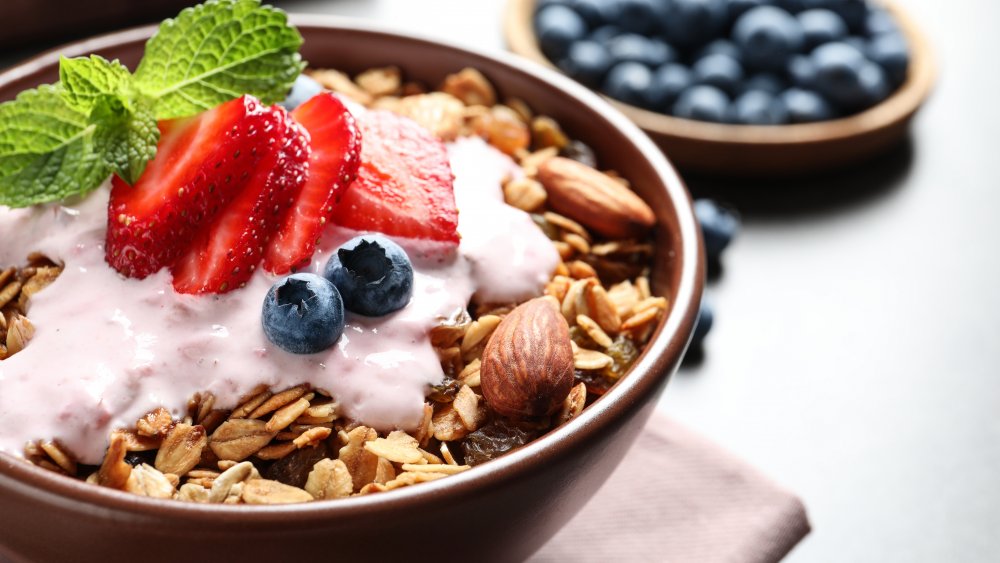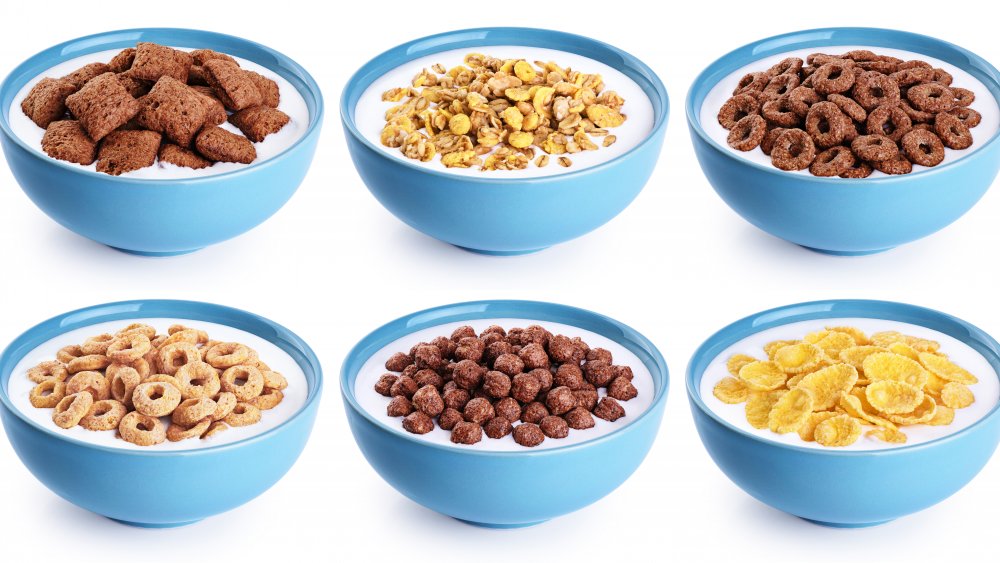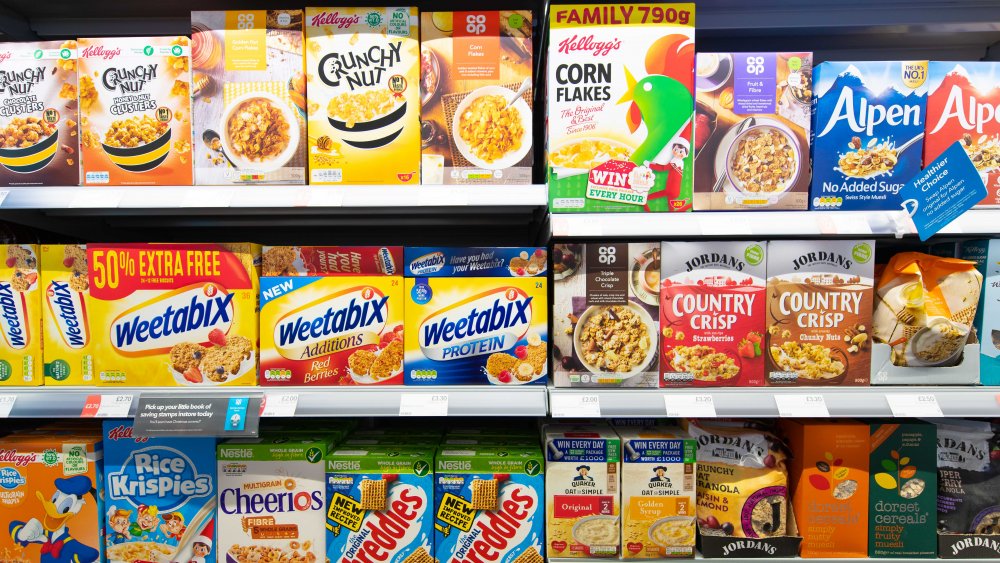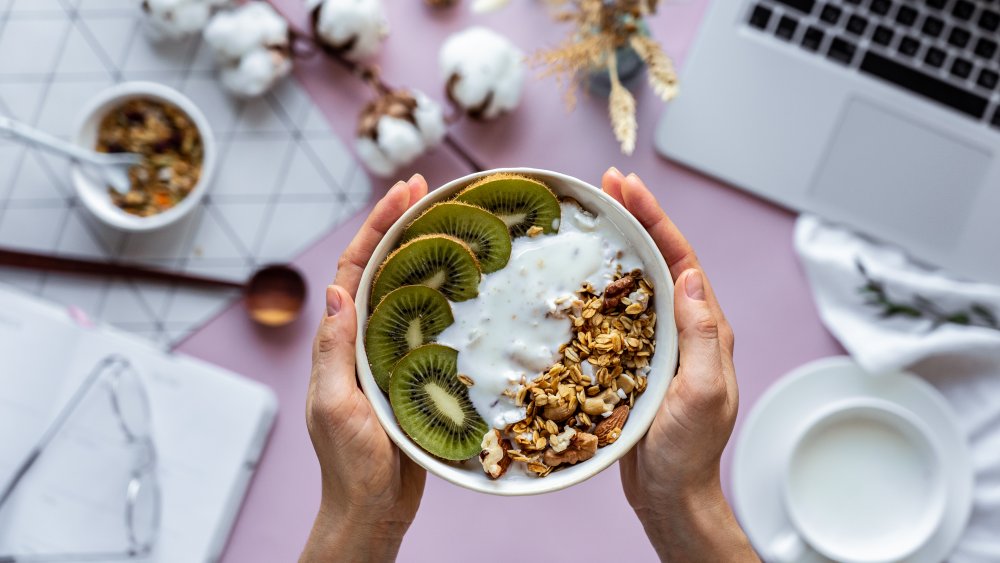Nutrition Expert Exposes The Cereals That Trick You Into Thinking They're Healthy
Jumpstart your morning with a cheery bowl of "whole grain" cereal and you'll be kicking off the day with a nutritious bang, right? Not necessarily. Read beyond the intrepid claims on the box and you might find that you're basically eating a bowl of sugar, devoid of nutrients and fiber. Might as well grab a candy bar on your way out the door. Even the most popular cereals need further investigation when it comes to truth in labeling. Some deserve a place in your cart, while others should be left on the shelf.
Products like Kellogg's Smart Start Antioxidants cereal, boasting "multi-grain flakes and crunchy oat clusters," imply that you're consuming a bowl of multivitamins. With words like "smart" and "antioxidants" in the title, it sure sounds like a cereal superhero. Turns out, one serving (1 1/4 cups) has 18 grams of sugar, and every speck of that sweetness is added (meaning it's not found naturally in the ingredients). Since when does a nutritious food need four different varieties of sweeteners to be palatable (sugar, brown sugar syrup, corn syrup, and honey)? Eighteen grams of the sugar found in this "smart start" is the sugar equivalent of a bag of M&M's.
Cereal or Pop-Tarts?
You'd think you'd be able to trust big companies like Kellogg's when it comes to truth in advertising. Not so fast. The company has agreed to pay over $20 million and change its marketing after a class action suit claimed they misled consumers by putting words like "healthy," "wholesome," and "nutritious" on cereals with massive amounts of sugar (per ClassAction.org).
But Kellogg's isn't the only culprit — many breakfast cereals have misleading health claims printed right on the front of the box. In big letters. What you think might be a nourishing way to start the day might actually be a bowl of refined grains and a disgraceful amount of sugar (per Healthline).
Take General Mills Cheerios Oat Crunch with Cinnamon, for example. The label says one serving (3/4 cup) delivers half of your whole grain recommendation for the day, and five types of whole grains, including oats, sorghum, and millet. Sounds admirable enough, but they should probably mention that one serving also contains 15 grams of added sugar. When sugar is the second ingredient, and honey isn't far behind, it's no surprise that a fistful of cereal has the sugar equivalent of a cherry Pop-Tart.
Better check your pantry for suspect cereals
The American Heart Association recommends limiting the amount of all added sugars (not referring to naturally-occurring sugar found in fruits, etc.) to no more than half of your daily discretionary calories. Discretionary calories are the calories you consume after you've met your nutritional needs for the day, and they're typically empty calories, meaning they lack nutrients and fiber (via Nestlé Institute). For most American women, that means no more than 100 calories per day, or about 6 teaspoons of sugar. For men, it's 150 calories per day, or about 9 teaspoons. have one bowl of cereal, though, and you've reached your max for two days!
Don't be embarrassed if you just ran to your pantry and found some seemingly healthy cereals with less-than-stellar stats. According to Mic, many consumers see a single bold health claim on a product label and assume the product is nutritious. Instead of turning the package over to read the entire nutrition label, they trust that if it says it's healthy, it must be healthy, and into the cart it goes. According to Spoon University, most cereals on supermarket shelves contain more than half the recommended daily sugar intake for women in just one serving.
There's hope out there
The good news is, the cereal aisle isn't a desperate hallway of sugary, refined grains. There are plenty of wholesome choices out there, and you'll find them if you take your time and read labels.
When shopping, ignore the claims on the front of the box and check the nutrition label for the real deal. If the ingredient list starts with whole grain oats, but is followed by sugar, that's a no. In general, choose cereals that are high in fiber and low in sugar (per Eat This, Not That!). And, perhaps more importantly, try to avoid products with a boatload of added sugar.
Men's Health magazine found a plethora of healthy, delicious-tasting cereals, from muesli, to oats, to granola, to good old-fashioned oat Os. That means there's a really good chance you, too, will find something nourishing and satisfying at the same time. Shop wisely and you can enjoy a bounty of nourishing whole grains, quell your cereal cravings, and get your day off to a great start.
Robin Miller is a nutritionist, chef, and food writer.



